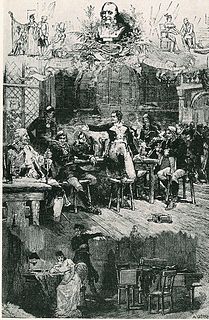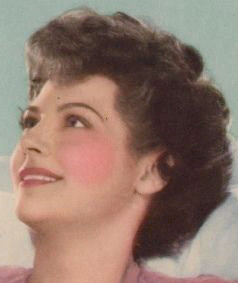
The Red Shoes is a 1948 British drama film written, directed, and produced by Michael Powell and Emeric Pressburger, and starring, in the same order as the movie's opening credits, Anton Walbrook, Marius Goring and Moira Shearer. It follows the beautiful Victoria Page, played by Moira Shearer, the ballerina who joins the world renowned Ballet Lermontov, owned and operated by Boris Lermontov, played by Anton Walbrook, who ultimately tests her dedication to the ballet, when she must choose between her career and a romance with composer Julian Craster, played by Marius Goring. It marked the feature film debut of Shearer, an established ballerina, and also features Robert Helpmann, Léonide Massine, and Ludmilla Tchérina, other renowned dancers from the ballet world. The plot is based on the 1845 eponymous fairytale by Hans Christian Andersen, and features a ballet within it by the same title, also adapted from the Andersen work.

Michael Latham Powell was an English film director, celebrated for his partnership with Emeric Pressburger. Through their production company "The Archers", they together wrote, produced and directed a series of classic British films, notably The Life and Death of Colonel Blimp (1943), A Canterbury Tale (1944), I Know Where I'm Going! (1945), A Matter of Life and Death, Black Narcissus (1947), The Red Shoes (1948), and The Tales of Hoffmann (1951). His later controversial 1960 film Peeping Tom, while today considered a classic, and a contender as the first "slasher", was so vilified on first release that his career was seriously damaged.

A Canterbury Tale is a 1944 British film by Michael Powell and Emeric Pressburger starring Eric Portman, Sheila Sim, Dennis Price and Sgt. John Sweet; Esmond Knight provided narration and played two small roles. For the post-war American release, Raymond Massey narrated and Kim Hunter was added to the film. The film was made in black and white, and was the first of two collaborations between Powell and Pressburger and cinematographer Erwin Hillier.

Emeric Pressburger was a Hungarian-British screenwriter, film director, and producer. He is best known for his series of film collaborations with Michael Powell, in a collaboration partnership known as the Archers, and produced a series of films, including 49th Parallel (1941), The Life and Death of Colonel Blimp (1943), A Matter of Life and Death, Black Narcissus (1947), The Red Shoes (1948), and The Tales of Hoffmann (1951).

The Tales of Hoffmann is an opéra fantastique by Jacques Offenbach. The French libretto was written by Jules Barbier, based on three short stories by E. T. A. Hoffmann, who is the protagonist of the story. It was Offenbach's final work; he died in October 1880, four months before the premiere.

A Matter of Life and Death is a 1946 British fantasy-romance film set in England during the Second World War. Written, produced and directed by Michael Powell and Emeric Pressburger, the film stars David Niven, Roger Livesey, Raymond Massey, Kim Hunter and Marius Goring.

The British film-making partnership of Michael Powell (1905–1990) and Emeric Pressburger (1902–1988)—together often known as The Archers, the name of their production company—made a series of influential films in the 1940s and 1950s. Their collaborations—24 films between 1939 and 1972—were mainly derived from original stories by Pressburger with the script written by both Pressburger & Powell. Powell did most of the directing while Pressburger did most of the work of the producer and also assisted with the editing, especially the way the music was used. Unusually, the pair shared a writer-director-producer credit for most of their films. The best-known of these are The Life and Death of Colonel Blimp (1943), A Canterbury Tale (1944), I Know Where I'm Going! (1945), A Matter of Life and Death (1946), Black Narcissus (1947), The Red Shoes (1948), and The Tales of Hoffmann (1951).

The Small Back Room, released in the United States as Hour of Glory, is a 1949 film by the British producer-writer-director team of Michael Powell and Emeric Pressburger starring David Farrar and Kathleen Byron and featuring Jack Hawkins and Cyril Cusack. It was based on the 1943 novel of the same name by Nigel Balchin.

Oh... Rosalinda!! is a 1955 British musical comedy film by the British director-writer team of Michael Powell and Emeric Pressburger. The film stars Michael Redgrave, Mel Ferrer, Anthony Quayle, Ludmilla Tchérina and Anton Walbrook and features Anneliese Rothenberger and Dennis Price.

Pamela Mary Brown was an English stage and film actress.
Robert Rounseville was an American actor and tenor, who appeared in opera, operetta, and Broadway musicals.
Richard Jones CBE is a British theatre and opera director. He was born in London, and studied at the University of Hull and University of London. After working as a jazz musician, he spent 1982–83 on a bursary working with Scottish Opera and the Citizens Theatre.

The 4th Cannes Film Festival was held from 3 to 20 April 1951. The previous year, no festival had been held because of financial reasons. In 1951, the festival took place in April instead of September to avoid direct competition with the Venice Film Festival.

Herzog Blaubarts Burg (1963) is a film of the opera Bluebeard's Castle by the Hungarian composer Béla Bartók, written in 1911 to a symbolist libretto by the poet and later film theorist Béla Balázs. The film was made for West German television, Süddeutscher Rundfunk, and was produced by Norman Foster, who also performs the lead role. The designer was Hein Heckroth who brought in his old friend Michael Powell, for whom he had designed a number of films, to direct it. The film, which was shot at Dürer Film Ateliers in Salzburg, Austria, was out of circulation for decades because of legal problems.
Tales of Hoffmann is a 1916 silent German drama film directed by Richard Oswald. An incomplete print is held in the collection of the Friedrich Wilhelm Murnau Foundation.
Monica Sinclair was a British operatic contralto, who sang many roles with the Royal Opera, Covent Garden during the 1950s and 1960s, and appeared on stage and in recordings with Joan Sutherland, Luciano Pavarotti, Maria Callas, Sir Thomas Beecham, Sir Malcolm Sargent and many others. She had a great gift for comedy, and sang in recordings of many of the Gilbert and Sullivan operettas, as well as in recordings from the standard operatic repertory.

Dennis Drew Arundell OBE was a British actor, librettist, opera scholar, translator, producer, director, conductor and composer of incidental music.
Dorothy Mary Bond was an English coloratura soprano whose star shone brightly but briefly. She was noted for the purity of her tone and the accuracy of her intonation. She became a favourite singer of Sir Thomas Beecham's, recording the voice of Olympia for the Powell and Pressburger film of Offenbach's The Tales of Hoffmann in 1950. She also recorded Delius's A Village Romeo and Juliet under Beecham, and Ernest Bloch's Sacred Service under the composer. She was killed in a road accident at the age of 31 years old.

Ann Ayars was an American soprano and actress. Early in her career she acted in several TV series and non musical films. Later, she sang with the New York City Opera (NYCO), and became known worldwide when she sang and acted the part of Antonia in the 1951 British film The Tales of Hoffmann.

Melitta Muszely is an Austrian operatic soprano and a voice teacher. She made a career based in Germany, mainly at the Hamburg State Opera with guest contracts to the Komische Oper Berlin and the Vienna State Opera, among others. She took part in world premieres, and performed internationally in Europe. She appeared as all four female characters in Offenbach's Hoffmanns Erzählungen in the legendary 1958 production by Walter Felsenstein, and sang recitals until 2008.














